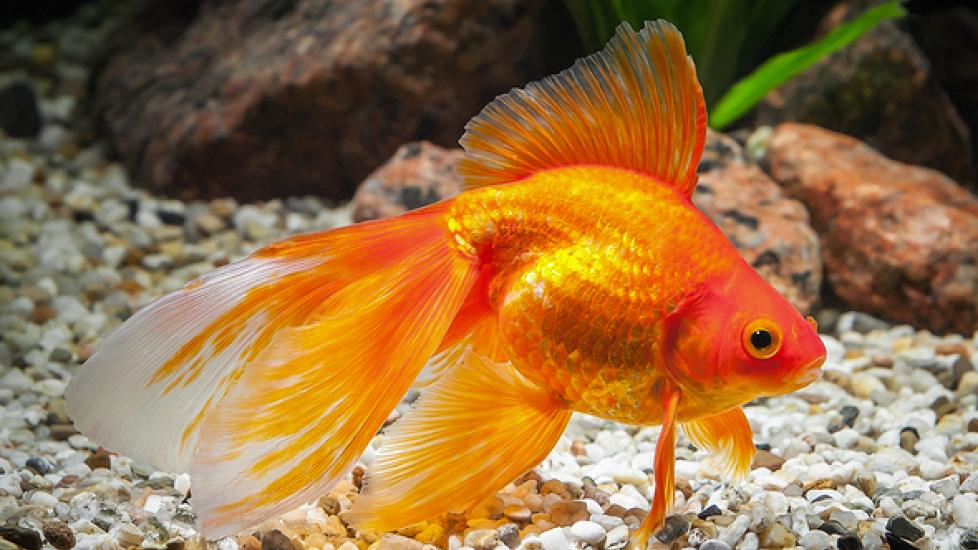How Long Do Fish Live?
By Adam Denish, DVM
You may be searching for the answer to the ultimate question, “How long will my fish live?” Scientists around the globe have dedicated their careers to studying lifespans of people and animals to determine why some animals, like Galapagos tortoises, can live well over 100 years while a field mouse only lives two or three years.
An animal’s life span is affected by a number of genetic factors including physical size, heart efficiency, metabolism, age of reproductive maturity and length of reproductive viability. Environmental factors including disease, predation, drought and starvation are also at play in determining the lifespan of an animal. When we pose the question of how long our fish will live, we need to consider how well the fish is fit for life genetically and then assess the environmental risks.
While determining the life expectancy for individual fish can be more of a guessing game, we can use some indicators about size, reproduction and the environment to give some broad determinations.
Size Indicators that Determine How Long Fish Live
Physicist Dr. Geoffrey West has made a correlation between size and cell efficiency and applies methods he uses to determine the energy needs of different-sized cities to the way living organisms use energy. West puts cells of organisms on an even playing field and then scales their needs by a factor related to their physical size. West explains that if a mouse and an elephant both have the same number of heart beats in their respective lifetimes, the difference in life expectancy would be determined by the rate of their metabolism. The elephant lives a more efficient and longer life due to slower metabolism.
We can take this assertion and apply it to tropical fish as well. It is true that larger fish like plecos, Oscars and clown loach have a longer life expectancy than small fish like bettas or killifish. These large fish are the elephants in the aquarium.
Reproductive Indicators that Determine How Long Fish Live
Passing genes on to the next generation is nature’s ultimate goal. Fish have all sorts of strategies to ensure that reproduction happens and these strategies are closely tied to lifespan. For example, Atlantic salmon begin life in freshwater and eventually swim out into the open ocean to grow and mature for about five years. Salmon make a long and treacherous journey back to the area where they were born to spawn and then usually die within days. These egg-laying fish tend to live longer than live-bearing fish.
Aquarium fish such as tetras, hatchetfish and gouramis are all egg-layers and can reach a life-span of about five years. Other egg-layers like catfish, silverdollars and goldfish have been able to live for 10 years or longer in home aquariums. Live-bearing fish like guppies, mollies and platys are common in the community fish tank and readily reproduce in captivity. These fish live a comparatively shorter life span, only about three-to-five years.
Environmental Indicators that Determine How Long Fish Live
While fish come to our tanks with a somewhat predetermined shelf life, that time can be shortened or extended based on factors such as the water quality, tank mates, susceptibility to disease and housing obstacles. To give your fish the best chance at living a full life, follow these recommendations:
- Stick to a schedule. Fish, like most animals, fare best when their world runs on a fairly predictable timetable. Avoid stress for your fish by keeping a consistent schedule for issues such as feeding, hours of light and water changes.
- Beware of frenemies. Even fish who should be compatible with others can turn into bullies. Bullying is a common problem among fish. Fish can become bullies if they feel their territory is threatened or if they are defending nesting areas. To ward off bullying, provide lots of space and hiding areas in your tank. A fish that is being bullied and cannot hide will become stressed and prone to illness. Rearranging your tank might slow down the bullying behavior as the fish will re-establish territories.
- Monitor water chemistry. Keep a checklist and monitor factors such as pH level, temperature and ammonia in your tank. In a closed system, if something goes unchecked, the lives of your fish could be compromised.
- Practice disease prevention. Notice if fish are gasping for air at the top, exhibiting darting behavior, scratching on the rocks or are appearing pale or darkened in color—these behaviors may be an indication of illness and warrant further investigation. Skin ailments like white spots or a cottony covering could be a sign of a contagious skin disease that needs to be treated.
Tracking the longevity of fish can be a little tricky as owners rarely know the birthday of their fish. The majority of common tropical fish live for an average of three to five years, while goldfish are among those living the longest, potentially up to 20 years. Koi, who are cousins of the goldfish, can live up to 40 years.
If a long life is a goal for your fish hobby, seek out larger species such as catfish, Cichlids, Pacus and Loach. Whichever fish you fancy, aim for making the years they spend in your tank healthy and happy.
